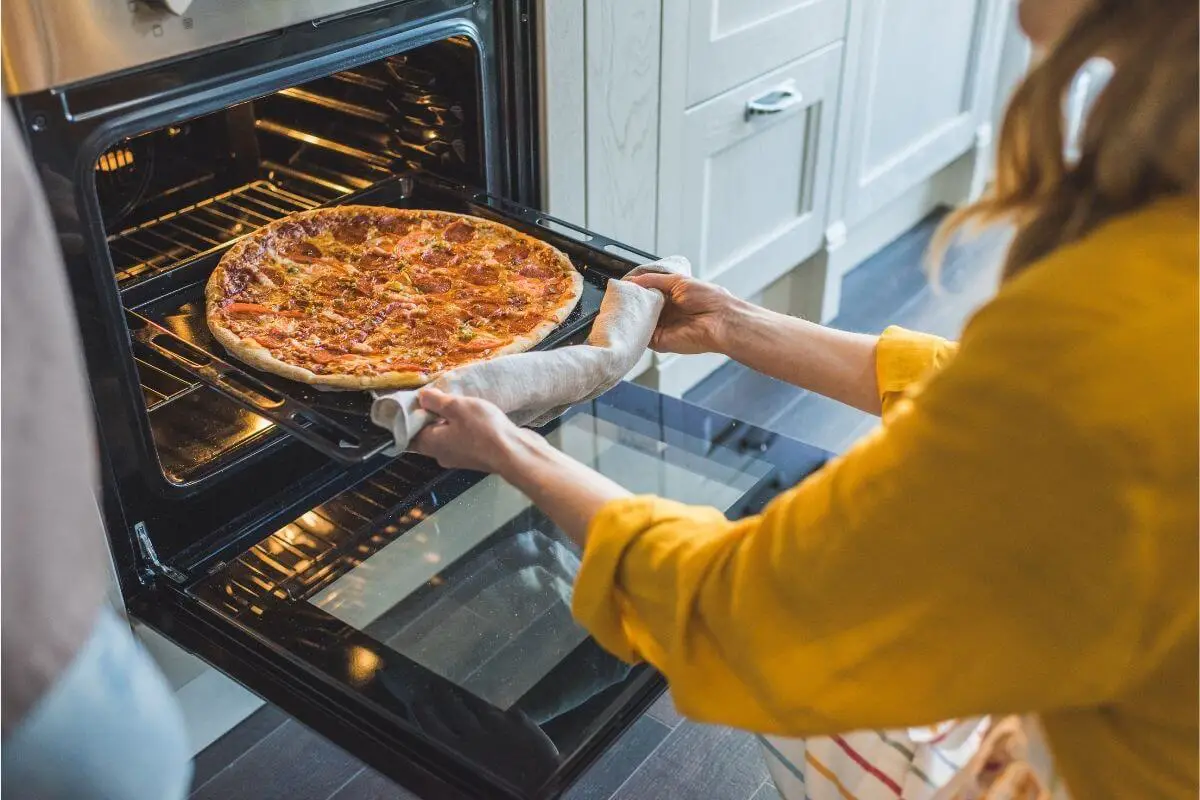Does Pizza Oven Need a Hood? A Clear and Knowledgeable Guide
Last updated on September 11th, 2023 at 02:11 pm
Are you a pizza lover who’s considering bringing a pizza oven into your kitchen? If so, you might be wondering whether or not you need to install a hood to keep your oven running efficiently.
While a hood can help remove vapors and heat generated during cooking, it’s not always necessary. In fact, there are several factors to consider before making a decision.
So, how do you know if a hood is right for your pizza oven? Let’s explore the pros and cons together and find out how you can make the best decision for your unique situation.
Understanding the Need for Hood in Pizza Ovens

Concept of Heat and Cooking
When it comes to pizza ovens, heat is a critical factor for achieving the perfect crust, cheese melt, and overall deliciousness.
Modern pizza ovens are efficient in heat usage, which means they retain high temperatures for longer periods while also ensuring that the exterior remains relatively cool.
However, heat isn’t the only thing to consider when it comes to these ovens.
Role of Ventilation in Cooking
Proper ventilation plays a significant role in maintaining the safety and efficiency of your pizza oven.
Ventilation systems, such as hoods, help regulate the air quality in your cooking area by:
- Removing excess heat that builds up during the cooking process.
- Controlling smoke and odors that may arise from cooking.
- Ensuring proper circulation of air, preventing the buildup of carbon monoxide (especially in gas-fired ovens).
- Keeping the oven’s optimal performance by preventing excess fumes and moisture from affecting the cooking process.
Not only does proper ventilation improve the overall efficiency of your pizza oven, but it also ensures a safer and more comfortable cooking environment.
When heat, smoke, and fumes are efficiently managed, you and your guests can enjoy the process of crafting delicious homemade pizzas without worrying about potential safety hazards or inconveniences.
In summary, hoods play an essential role in managing heat and ventilation in pizza ovens. With proper hood installation, your oven will continue to perform at its best while maintaining a safe and efficient cooking environment.
Remember to prioritize safety, exhaust, and ventilation aspects to get the most out of your pizza-making experience.
Types of Pizza Ovens: Hood vs. Hoodless
Indoor vs. Outdoor Pizza Ovens
When considering the type of pizza oven you want, one of the first decisions you’ll need to make is whether to go for an indoor or outdoor pizza oven.
Indoor pizza ovens are ideal for those who prefer to cook in the comfort of their own kitchen. They’re typically smaller and designed to fit on countertops or inside cabinets.
These ovens usually require a hood to help ventilate the air and remove heat efficiently, preventing potential overheating and other hazards.
On the other hand, outdoor pizza ovens come in various shapes and sizes, from compact portable models to large built-in installations.
There’s no denying the appeal of cooking a pizza in your backyard or patio, surrounded by the smell of wood-fired pizza.
Outdoor ovens may not always require a hood due to the open-air environment.
However, you’ll need to consider the distance between your pizza oven and your house, as heat and smoke can pose a risk if too close.
Commercial vs. Personal Use Ovens
Another important factor to keep in mind is the intended purpose of your pizza oven.
When it comes to commercial pizza ovens, a hood system is often required for various reasons:
- To meet building codes and safety regulations for food establishments
- To help with proper ventilation, especially in large, busy kitchens
- To maintain a comfortable working temperature for kitchen staff
On the other hand, personal-use pizza ovens may not always require a hood. The need for a hood will depend on the specific model and where you plan to install it.
Keep in mind the safety aspect, as proper ventilation is essential, especially if you’re using an indoor oven or a high-heat oven in an enclosed space.
Consider the following pros and cons of having a hood:
Pros
- Better air quality and heat ventilation
- Reduces the risk of smoke and grease buildup
- Can improve the efficiency of your pizza oven
Cons
- Additional cost and space requirements
- Some outdoor models may not require a hood, making it an unnecessary expense
- It can be difficult to install and maintain
When selecting your pizza oven, consider factors such as indoor vs. outdoor use, commercial or personal use, and the safety and practical implications of whether or not a hood is necessary.
Ensuring that you put your pizza oven in the right place will be key to getting the most out of your oven and enjoying delicious homemade pizza!
How Oven Hoods Function
When it comes to cooking pizza, maintaining a clean and comfortable kitchen environment can be challenging. This is where oven hoods come in handy.
In this section, we’ll explore how oven hoods function, focusing on odor and smoke control and temperature regulation.
Odor and Smoke Control
One of the primary functions of an oven hood is to control odors and smoke in your kitchen. When you’re cooking pizza, the heat from the oven can cause smoke and strong aromas.
This is particularly true if you’re using appliances like Ooni pizza ovens, which can reach high temperatures.
An oven hood effectively captures these byproducts and directs them outside or through a filtration system, keeping your kitchen smelling fresh and free of smoke.
Temperature Regulation
Another crucial aspect of oven hood functionality is temperature regulation. As you cook, especially with pizza ovens, the heat generated can make your kitchen uncomfortably warm.
An oven hood helps to maintain a comfortable temperature by removing excess heat from the oven and venting it outside.
This prevents overheating and ensures that your pizza cooks at the optimal temperature without burning or overcooking.
In summary, oven hoods serve essential functions in managing odors, smoke, and temperature when cooking pizza.
By incorporating one into your kitchen setup, you’ll enjoy a cleaner, more comfortable, and efficient cooking environment.
Installation and Maintenance of Pizza Oven Hoods
Installation Process
To ensure the proper functioning and safety of your pizza oven, it’s essential to install a hood correctly. First, find a suitable location that accommodates the size of the hood and allows for adequate clearance around the oven.
It’s crucial to follow the manufacturer’s guidelines for the specific hood model you’re using.
After selecting the location, securely attach the hood to the oven, making sure the vent is positioned correctly to effectively remove vapors and smoke.
Additionally, proper ventilation is necessary for maintaining the oven’s performance and safety.
Connecting the hood to an exhaust system or incorporating it into an existing ventilation setup, such as a chimney, can help to disperse fumes and heat.
Before starting the installation process, familiarize yourself with local codes and regulations to ensure compliance. Some areas may require a professional installer to handle the process.
Regular Maintenance and Cleaning
Regular maintenance and cleaning of your pizza oven hood are essential for optimal operation and the longevity of your equipment.
It’s a good practice to inspect your hood and exhaust system regularly for signs of wear, damage, or blockages.
Keep an eye out for any issues that may require attention, and address them promptly to avoid potential hazards.
Cleaning your pizza oven hood is crucial for preventing the buildup of grease, soot, and debris that can hinder the hood’s effectiveness.
Here are some steps for thorough cleaning:
- Turn off and unplug the pizza oven before cleaning.
- Remove any removable parts such as filters, screens, or grates.
- Use a mild soap, warm water, and a soft-bristle brush to gently scrub all surfaces.
- Rinse thoroughly with warm water and allow everything to air dry.
- Reassemble the hood after ensuring all components are clean and dry.
Keep in mind that some hoods may have specific cleaning requirements, so always consult your owner’s manual for any model-specific instructions.
Additionally, consider consulting Ooni Pizza Oven Troubleshooting if you encounter problems or need further guidance in maintaining optimal performance and safety.
By following these installation and maintenance guidelines, you can ensure your pizza oven remains in top-notch condition, enabling you to continue enjoying delicious homemade pizzas.
Safety Regulations and Building Codes
When it comes to pizza ovens, understanding safety regulations and building codes is crucial to ensure a safe and compliant setup. Installing the appropriate hood can prevent hazards and maintain proper air quality in any commercial or residential setting.
International Building Code
The International Building Code (IBC) contains guidelines concerning the safe installation and operation of cooking appliances, including pizza ovens.
The IBC sets standards that must be followed to ensure compliance with local building codes and regulations.
Failure to adhere to these standards can result in fines, penalties, and damage to your business or property.
It’s essential to consult your local building department for specific requirements related to pizza ovens and hoods in your area, as these regulations may vary depending on your jurisdiction.
Type 1 and Type 2 Hoods
There are two primary types of commercial kitchen hoods used in conjunction with pizza ovens – Type 1 and Type 2 hoods.
Type 1 Hoods are designed for collecting grease-laden vapors and contaminants produced during cooking.
These are typically used for high-heat appliances that generate a significant amount of grease and smoke, such as grills and deep fryers.
- Pros:
- Better suited for high-grease appliances
- Removes a significant amount of heat and smoke from the cooking area
- Highly effective at preventing fires and maintaining air quality
- Cons:
- Usually more expensive to install and maintain
- It may require more extensive ductwork and exhaust system components
Type 2 Hoods are designed for general ventilation and temperature control in low to moderate grease-producing appliances, such as pizza ovens.
While Type 2 hoods may not be the best option for heavy-grease applications, they can effectively handle the ventilation requirements of a pizza oven.
- Pros:
- Less expensive to install and maintain compared to Type 1 hoods
- Adequate ventilation for most pizza ovens
- Easier to integrate into existing kitchen designs
- Cons:
- Not suitable for high-grease appliances
- It may not remove heat and smoke as effectively as Type 1 hoods
When choosing between Type 1 and Type 2 hoods, it’s crucial to consider your specific pizza oven and its ventilation requirements.
Always consult with a professional and follow local building codes to ensure a safe, compliant installation.
Effects of Oven Hood on the Environment
Installing an oven hood for your pizza oven has some important effects on the environment. A few of these are related to pollutants and emissions. Let’s dive into the details.
First, a pizza oven hood is essential for proper ventilation. By installing a hood, you will be able to efficiently remove pollutants such as smoke and fumes from the cooking process.
This can greatly improve the air quality in your immediate environment, especially if you’re cooking in an enclosed space.
Another point to consider is the effect of a hood on energy consumption. A well-insulated and properly ventilated pizza oven could mean you require less fuel to maintain the high temperatures needed for cooking.
This results in a reduction of greenhouse gas emissions and a more environmentally friendly cooking process.
There are potential downsides to consider as well. For example, incorrectly installed hoods can result in a backdraft.
This occurs when a lack of air in the room creates a change in pressure, causing fumes and smoke to be pulled back inside.
This can lead to a buildup of harmful pollutants that might pose health risks and negatively impact the environment.
To sum it up, using a pizza oven hood has several positive effects on the environment, such as:
- Improved ventilation
- Reduced pollutants and emissions
- Lower energy consumption
However, proper installation is crucial to avoid potential negative impacts like backdrafts.
Remember, you have the power to create a more environmentally friendly cooking experience by making informed choices about your pizza oven and its ventilation system.
Commercial Use and Image Projection
When it comes to using a pizza oven in a commercial setting, having a hood is more than just a practical necessity.
It also influences the image you project to your customers. After all, maintaining a clean, professional environment is crucial for attracting and retaining patrons.
A well-ventilated workspace can create a positive ambiance for your customers, as it eliminates the smoke, heat, and grease produced by the pizza oven.
With a hood over a commercial pizza oven, you ensure that your kitchen maintains an efficient and pleasant atmosphere.
Furthermore, a hood system not only protects your property from potential damage like smoke and heat but also contributes to a healthier work environment for your staff.
By installing the appropriate hood system, you show your commitment to employee safety and wellness, which in turn reflects positively on your business’s image.
In terms of aesthetics, incorporating a well-designed hood into your pizza oven setup can enhance the overall appearance and professionalism of your establishment.
Customers tend to associate sleek, well-maintained equipment with a higher-quality dining experience.
Here are just a few reasons why a hood is important for your pizza oven in a commercial setting:
- Improves overall kitchen ventilation
- Enhances the comfort and experience of customers
- Promotes a safe and healthy work environment
- Contributes to a professional and modern appearance
Remember that local health and fire officials should always be consulted when determining the specific requirements for your business’s hood system source.
Following these guidelines and prioritizing proper ventilation will not only ensure the safety of your commercial kitchen but also project a positive image to your customers.











